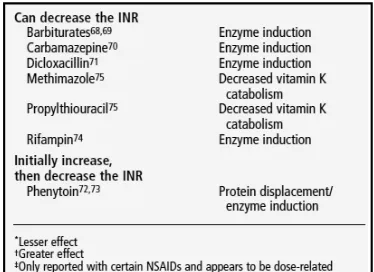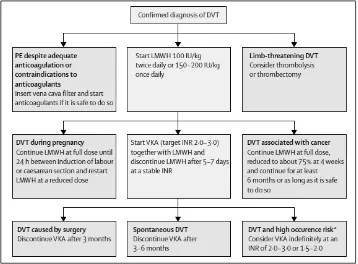Acta Cardiologia Indonesiana (Vol 1 No. 1): 13-16
13
The Role of Anticoagulant and Thrombolysis in The Management of Deep Vein Thrombosis
Anggia Endah Satuti, Hariadi Hariawan, Hasanah Mumpuni
Department of Cardiology and Vascular Medicine, Faculty of Medicine, Universitas Gadjah Mada, Yogyakarta / Sardjito General Hospital YogyakartaIntroduction
Deep vein thrombosis (DVT) is a clinical challenge encountered by clinicians of all specialties. The major complication to date is thrombus embolization into the lung which can be fatal.1 The mainstay of DVT therapy is an
anticoagulant to prevent the thrombus development and recurrence. However, anticoagulant has no direct thrombolysis effect and recanalization of DVT largely depends on the effectiveness of the endogenous fi brinolytic system.2 Many agents are
developed to improve the outcome and prevent a post thrombotic syndrome (PTS). The aim of this review is to give explanation on the use of anticoagulant, especially vitamin K antagonist, warfarin and thrombolytic therapy in DVT.
The Management of DVT
The therapy of choice in DVT consist of anticoagulant, vena cava fi lter, thrombolytic agents and surgical thrombectomy.
Anticoagulant
Anticoagulant therapy in DVT consist of the use of heparin and oral anticoagulant. Due to an unacceptable rate of recurrent venous thromboembolic complication with the use of sole oral anticoagulation, heparin are used for 5-10 days in concomitant with oral anticoagulants.3 Warfarin,
an oral anticoagulant, needs unfractionated heparin or low-molecular-weight heparin during the fi rst few days of warfarin therapy as a “bridge”, as warfarin therapy may take up to 5 days to achieve its antithrombotic effect. This is due to the long half-life of circulating prothrombin which is 60 days.4
[image:1.595.316.503.499.635.2]Warfarin is still an important drug with many clinical indication. In the most clinical cases, the rate of thromboembolism is reduced by the use of this vitamin K antagonist. Unfortunately, warfarin interacts with some food and many medicines. The interaction can affects an INR level, an indicator of blood anticoagulation state. Foods that contain high level of vitamin K may affect warfarin activity. Some medicines that can increase or decrease INR level are listed in table 1.
Satuti et al., 2015
14 For the fi rst fi ve to ten days, warfarin initiation consists of the use of unfractionated heparin (UFH), low molecular weight heparin (LMWH) or pentasaccharide (fondaparinux) concurrently with warfarin. Unfractionated heparin could be given with fixed dose 1250 IU/hour or using body weight, 80 IU/kg body weight intravenous bolus and maintain with 18 IU/kg body weight per hour. Alternative use of intravenous UFH is subcutaneous UFH with fi xed dose 333 IU/kg body weight dan 250 IU/kg body weight per day. Both modalities, either intravenously or subcutaneously, has already been tested in 972 patients and subcutaneous UFH has comparable efectivity and safety as compare with UFH intravenous.7
The American College of Chest Physician (ACCP) recommends warfarin therapy in the fi rst day dan titrated to achieve target INR >2.8 The
length of anticoagulant therapy is based on the clinical disease. Figure 1 shows anticoagulant duration for DVT.
Hemorrhage is still the major concern of oral anticoagulant therapy and warfarin poses this risk.5
In many clinical studies, treatment with warfarin increases the risk of major bleeding by 0.3-0.5% per year and the risk of intracranial hemorrhage approxiamately 0.2% per year compared to controls. Risk of major bleeding in warfarin use can be lowered with strict monitoring. There is a need to outweigh the risk of bleeding and the benefi t of the therapy. Phrotrombin time (PT) or International Normalized Ratio (INR) are used to monitor warfarin level. The target of INR in patient using warfarin is 2-3 and this value causes less risk of bleeding as compare to the target of INR > 3.6 Table 2 show the frequency of
[image:2.595.118.476.85.349.2]monitoring in warfarin initiation. Figure 1. Protocol therapy of deep vein thrombosis 9
[image:2.595.122.467.393.510.2]Acta Cardiologia Indonesiana (Vol 1 No. 1): 13-16
15 With the use of optimal anticoagulant, repeated venography in six month after DVT therapy in femoral vein and other distal veins shows complete lysis in 38% patients, partial resolution in 54% and propagation in 7%.11 Moreover, in 1 year after
therapy, vein abnormalities using compression ultrasonography were found in 50% patients.11
Despite anticoagulation, infl ammatory reaction may develop within 7-10 days after acute onset of disease. Infi ltration of fi broblast and neovascularization will damage the venous valve and cause post thrombotic syndrome (PTS). Post thrombotic syndrome is caused by chronic venous hypertension secondary to venous refl ux, venous obstruction and valvular dysfunction. It is estimated that 80% patients with DVT may go on to develop symptoms of PTS while 4-15% progress to leg ulceration.12 It is believed
that rapid recanalization in DVT could prevent the development of PTS.2 However, studied showed
that anticoagulant has no direct thrombolysis effect and recanalization on DVT largely depends on the effectiveness of the endogenous fi brinolytic system.2
Researchers began to look for agents that could do rapid recanalization in DVT to prevent complication and reccurence.
Thrombolytic Agents
Randomized trials have consistently shown that thrombolytic therapy rapidly resolves thromboembolic obstruction and exerts benefi cial effects on haemodynamic parameters. Regimens that are approved are streptokinase, urokinase and rtPA. Approxiamately 94% of patients can be classifi ed based on clinical and echocardiographic improvement within the first 36 hours. The greatest benefi t is observed when treatment is initiated within 48 hours of symptom onset, but thrombolysis can still be useful in patients who had symptoms for 6-14 days.13
Thrombolytic therapy poses signifi cant risk of bleeding with overall bleeding rate is 13% and 1.8% major bleeding and intracranial hemorrhage.13
However, even with the increase risk of bleeding, there come the greater benefi t of rapid recanalization. The earliest trial in thrombolytic therapy was conducted by Robertson et al. in 1968 that compare streptokinase vs. heparin in 16 DVT subjects. In this trial, there were signifi cant lysis of thrombus in streptokinase group (63%) compared to in heparin group (12%). Risk of bleeding also increased in streptokinase group (25%) compared to in heparin group (12%). In
Cochrane Analysis consisted of 12 studies and 701 subjects overall, relative risks for major bleeding is 1.7 (95% CI, 1.04 to 2.9; 668 subjects in 10 studies) and signifi cant intracranial hemorrhage 1.7 (95% CI, 0.2 to 14; 701 subjects in 5 studies) in thrombolytic group.10 However, looking at the balance between
benefi t of rapid recanalization and risk of bleeding, in some patients the benefi t of rapid recanalization outweigh the risk of bleeding.
Catheter directed thrombolysis (CDT) is a method to introduce plasminogen activator agents directly into the thrombus. This method is more efficient because it causes local thrombolysis and improves venous patency, and at the same time reduces the risk in systemically used thrombolysis.12 In the study comparing thrombolytic
given systemically and CDT, valvular competence is preserved in 44% of patients using CDT vs. 13% patients using systemic thrombolysis (p=0.049).14 Most CDT associated complications
are local and systemic hemorrhage. CDT related bleeding is 5-11% and higher rates are associated with prolonged infusion time and high doses of thrombolytic agents used.12
American College of Physician suggests the use of CDT in selected patients whose life expectancy are > 1 year, good functional status, extensive illiofemoral thrombosis and presenting soon after the onset of symptoms (<14 days) (level 2B evidence). This proposition is based on small RCTs, registry data, institusional series and variety of expert opinions.15
Conclusion
Anticoagulant and thrombolytic are two of the modalities use in the management of DVT. Anticoagulant is the mainstay therapy of DVT, but the risk of valve incompetency due to slowly resolving thrombus is high. This could lead to reccurence of DVT and PTS. Thrombolytic is an agent that conveys rapid recanalization to prevent complication of DVT. However the use of thrombolytic agent poses greater risk of bleeding and since the evidence of thrombolysis is based on small RCTs, this therapy is only reserved for selected patients.
References
Satuti et al., 2015
16 2. Wicky S.A.2009. Acute deep vein thrombosis.
Techniques in Vascular and Interventional Radiology, 12:148-153.
3. Lensing A.W.A., Prandoni P., Prins M.H., Buller H.R. 1999. Deep-vein thrombosis. The Lancet;353 (9151), p: 479-485.
4. `Bragg L., Jaffer A. 2003. Practical tips for warfarin dosing and monitoring. Cleveland Clinic Journal of Medicine. 70(4): 361-371. 5. Silva L.R., Sousa J.C., Calisto C., Noguera
J.M.B., Ravara L. 2007. Oral anticoagulant therapy. Revista Portugese Cardiology, 26(7):769-788.
6. Schulman S., Beyth R.J., Kearon C., Levine M.N. 2008. Hemorrhagic complications of anticoagulant and thrombolytic treatment. Chest, 133:257S-298S
7. Guyatt G.H., Crowther M., Akl E.A., Gutterman D.D., Schunemann H.J. 2012. Antithrombotic therapy and prevention of thrombosis, 9th ed: American College of Chest Physicians Evidence-Based Clinical Practice Guidelines. Chest; 141(2)(Suppl), p:7S-47S
8. Skinner N., Moran P. 2007. Case management adherence guidelines deep vein thrombosis. In: Skinner, N, Morran, P (eds.) Guidelines from case management for improving patient adherence to deep vein thrombosis medication therapy. Aston PA: Case Management Society of America.
9. Kyrlie P., Eichinger S. 2005. Deep vein thrombosis.The Lancet, 365: 1163-1174. 10. Stokes J. 2012. Guidelines for warfarin
management in the community.health services support agency state of queensland.
11. Kearon C., Kahn S.R., Agnelli G., Goldhaber S., Comerota A.J. 2008. Antithrombotic therapy for venous thromboembolic disease. Chest, 133:454S-545S.
12. Gogalniceanu P., Johnston C.J.C., Khalid U., Holt P.J.E., Hincliffe R. 2008. Indications for thrombolysis in deep venous thrombosis. European Journalof Vascular and Endovascular Surgery; 38(2), p:192-198
13. Torbicki A., Perrier A., Konstantinides S.2008. Guidelines on the diagnosis and management of acute pulmonary embolism.European Heart Journal, 29:2276-231514.
14. Laiho, M.K., Oikonen A., Sugano N., Harjola V.P., Lehtola A.L., Roth W.D. 2004. Preservation of venous valve function after catheter-directed and systemic thrombolysis for deep venous thrombosis.European Journal of Vascular and Endovascular Surgery; 28(4), p:391-396. 15. Patterson B.O., Hinchchliffe R., Loftus I.M.,

